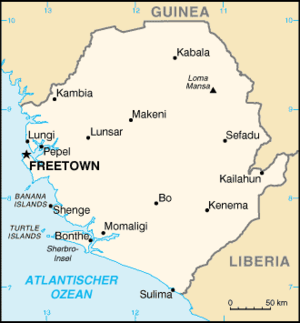Mamunta-Mayoso Wildlife Sanctuary
|
Mamunta-Mayoso Wildlife Sanctuary
|
|
| location | Sierra Leone |
| surface | 20.72 km² |
| WDPA ID | 1343 |
| Geographical location | 8 ° 35 ' N , 12 ° 10' W |
| Setup date | 1981 |
| administration | National Protected Area Authority |
Mamunta-Mayoso (or Mamunta-Mayawso ) is located in the center of Sierra Leone . It is one of the most important wildlife sanctuaries in the country and is the last refuge for some endangered animal species, including a. of the dwarf crocodile .
The park
introduction
The wildlife sanctuary consists of a variety of different vegetation zones. Boliland , a grass savannah that is flooded for several months a year, has the largest share . This is crossed by swamps, secondary forest and two lakes. The swamps reach a depth of up to 1.5 meters. The average annual precipitation is up to 3,000 millimeters. The daytime temperatures are around 30 ° C all year round.
A big problem for the reserve is that there is only one parking attendant. Illegal settlements and hunting increasingly threaten the rare flora and fauna.
getting there
Mamunta-Mayoso is one of the few protected areas in Sierra Leone that can be reached by car. The drive from Freetown takes about 5 hours. The route (about 35 kilometers) from Magburaka to the protected area is not paved and is not passable in the rainy season.
Accommodation and facilities
There is a small tourist information office in the protected area, or on the main road there. There is also a facility where the local population makes very good wicker products (e.g. baskets). Furthermore, there are no facilities or accommodations. The best place to spend the night is Makeni , around 50 kilometers north of the reserve.
fauna and Flora
Mammals
In addition to the extremely rare and endangered stump crocodile (dwarf crocodile), eight different primate species have been identified in the park . There are also bushbucks , bush pigs and duikers . A few pygmy hippos call the park their home.
Birds
252 bird species were observed between 1979 and 1991 , two of which are threatened with extinction.
Web links
- World Database on Protected Areas - Mamunta Mayosso Wildlife Sanctuary (English)
- Mamunta-Mayoso Wildlife Sanctuary , visitsierraleone.org

